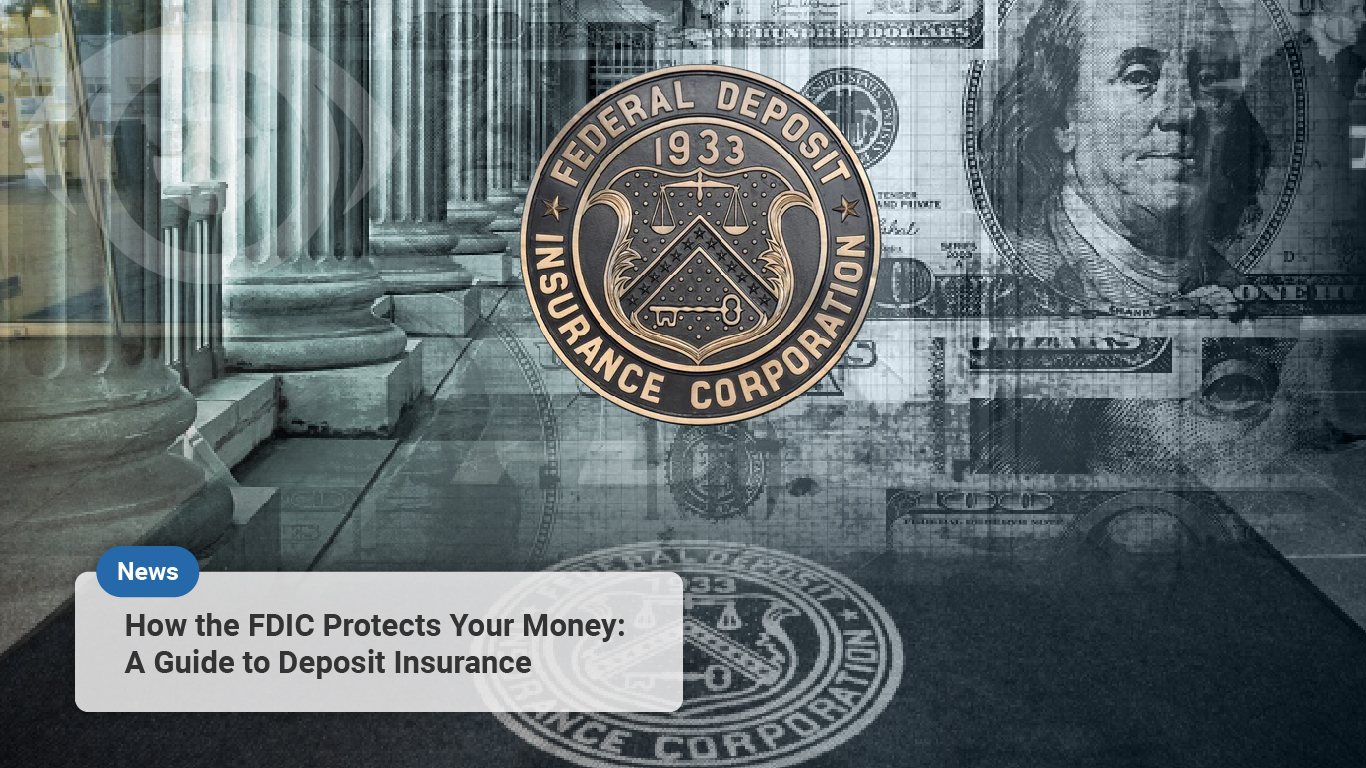Estimated reading time: 0 minutes
Table of contents
- I. Introduction
- II. What is the FDIC?
- III. What does FDIC insurance cover?
- IV. How much does the FDIC insure?
- V. Is FDIC insurance mandatory?
- VI. How do I know if my bank is FDIC insured?
- VII. What happens if my bank fails?
- VIII. How does the FDIC protect consumers?
- IX. Who funds the FDIC?
- X. How does the FDIC differ from the NCUA?
- XI. How can I file a complaint with the FDIC?
- XII. Conclusion
I. Introduction
United States government agency that was created in 1933 in response to the banking crisis of the Great Depression. The purpose is to provide deposit insurance to protect depositors in the event that a bank or savings institution fails. Also works to promote consumer protection and maintain stability in the banking system. In this article, we will discuss in more detail and answer some common questions about deposit insurance coverage.
II. What is the FDIC?
The Federal Deposit Insurance Corporation (FDIC) is responsible for insuring deposits at banks and savings institutions that are members of the FDIC. This means that if a bank or savings institution fails, will reimburse depositors up to a certain amount per account, typically $250,000 per depositor, per insured bank or savings institution. This deposit insurance helps protect consumers from losing their savings if a bank fails.
In addition to deposit insurance, also works to maintain stability in the banking system. The agency monitors banks and savings institutions for signs of financial distress and takes action when necessary to prevent bank failures. Also provides resources and support to help banks and savings institutions manage risks and maintain sound financial practices.
III. What does FDIC insurance cover?
FDIC insurance covers several types of deposit accounts, including checking accounts, savings accounts, money market accounts, and certificates of deposit (CDs). The insurance also covers accounts held in retirement plans, such as individual retirement accounts (IRAs). In general, any account that is held at a bank or savings institution that is a member of the FDIC is covered by deposit insurance.
However, it’s important to note that not all types of financial products are covered by FDIC insurance. For example, investments such as stocks, bonds, and mutual funds are not covered by deposit insurance. Similarly, deposit products that are not issued by banks or savings institutions, such as money market funds or annuities, are not covered by FDIC insurance.
It’s also important to understand that FDIC insurance only covers deposits up to a certain amount. The current insurance limit is $250,000 per depositor, per insured bank or savings institution. This means that if you have multiple accounts at the same bank or savings institution, the total balance of those accounts is insured up to $250,000. If you have accounts at different banks or savings institutions, each account is insured separately up to $250,000.
IV. How much does the FDIC insure?
The FDIC insures deposits up to $250,000 per depositor, per insured bank, or savings institution. This insurance limit is determined by federal law and is intended to protect most individual depositors at FDIC-insured institutions.
It’s important to note that the $250,000 limit applies to each depositor’s accounts at each FDIC-insured bank or savings institution. For example, if you have a checking account and a savings account at the same bank, both accounts are insured up to $250,000 separately. If you have accounts at different banks or savings institutions, each account is insured separately up to $250,000.
To maximize FDIC insurance coverage, there are several strategies you can use. One option is to open accounts at different FDIC-insured banks or savings institutions, rather than having all of your accounts at one institution. This spreads your deposits across multiple banks and increases the amount of FDIC insurance coverage you have.
Another option is to use different types of accounts, such as joint accounts or revocable trust accounts, which can provide additional insurance coverage beyond the basic $250,000 limit. However, it’s important to consult with a financial professional to ensure that these strategies are appropriate for your individual financial situation.
V. Is FDIC insurance mandatory?
FDIC insurance is mandatory for all banks that are chartered by the federal government. Banks that are chartered by state governments are not required to have FDIC insurance, but most choose to do so in order to provide depositors with peace of mind and attract more customers.
Credit unions, on the other hand, are not insured by the FDIC. Instead, credit unions are insured by the National Credit Union Administration (NCUA), which is a separate federal agency. However, like FDIC insurance, NCUA insurance provides similar deposit insurance coverage up to $250,000 per account.
It’s important to note that while FDIC insurance is not mandatory for all banks and savings institutions, most choose to participate in the program in order to provide depositors with confidence and security. If you are unsure whether your bank or savings institution is FDIC-insured, you can check with the institution or use the FDIC’s BankFind tool to verify the institution’s status.
VI. How do I know if my bank is FDIC insured?
Verifying if your bank or savings institution is FDIC-insured is easy. You can check for the FDIC logo or sign at the bank or savings institution’s physical location or website. Additionally, you can use the FDIC’s BankFind tool to look up the institution’s status.
To use the BankFind tool, simply enter the name of the bank or savings institution, the city, and state where it is located, or its FDIC certificate number. The tool will provide information about the institution, including its insurance status and history.
It’s important to make sure that your bank or savings institution is FDIC-insured in order to protect your deposits in the event of a bank failure. If you have any questions or concerns about insurance coverage or how to verify your bank’s status, you can contact them directly for assistance.

VII. What happens if my bank fails?
If your bank fails, the FDIC is responsible for handling the bank’s assets and liabilities in order to protect depositors and maintain stability in the banking system. The FDIC will typically step in when a bank is in danger of failing and attempt to find a buyer or merge the bank with another institution. If a buyer cannot be found, the FDIC will take over the bank’s operations and use its own resources to pay out insured deposits to depositors.
In the event that your bank fails, it’s important to know that FDIC insurance will protect your deposits of up to $250,000 per account. If you have more than $250,000 in deposits at the failed bank, you may lose some or all of the excess amount that is not covered by FDIC insurance.
The FDIC will typically notify depositors of a bank failure and provide instructions on how to access their insured deposits. If you have uninsured deposits or other investments at the failed bank, you may need to work with the FDIC to recover those funds through the bank’s liquidation process.
Overall, plays a crucial role in protecting depositors in the event of a bank failure, and it’s important to understand how FDIC insurance works and how to verify your bank’s status to ensure that your deposits are protected.
VIII. How does the FDIC protect consumers?
In addition to providing deposit insurance, the FDIC is also committed to protecting consumers from fraud and scams in the banking system. The agency works to promote consumer education and provides resources to help consumers make informed financial decisions and protect themselves from financial fraud.
One way that the FDIC promotes consumer education is through its Money Smart program, which provides financial education materials and resources for people of all ages and backgrounds. The program covers topics such as banking, credit, and managing money, and it is available in multiple languages.
Also works to protect consumers by monitoring the banking system for signs of fraud and taking action to shut down fraudulent activities. The agency works closely with other federal agencies and law enforcement to investigate and prosecute financial crimes.
Overall, the FDIC is dedicated to ensuring that consumers have access to safe and sound banking services and that they are protected from financial fraud and scams. By promoting consumer education and working to prevent fraudulent activities, the FDIC helps to maintain trust and confidence in the banking system.
IX. Who funds the FDIC?
Funded through a combination of sources, including premiums paid by member institutions, investment income, and earnings from its own operations. Member institutions are required to pay insurance premiums to the FDIC, which are based on the number of deposits they hold and their level of risk.
In addition to premiums, the FDIC also earns income from its investments and its own operations. The agency invests its funds in U.S. Treasury securities and other high-quality investments in order to earn a return on its assets. Also charges fees for services such as supervising and examining banks and savings institutions.
The FDIC’s funding model is designed to be self-sustaining, meaning that the agency does not receive any taxpayer funding. The premiums paid by member institutions are set at a level that is intended to cover the costs of the FDIC’s deposit insurance program and other operations.
Overall, the FDIC’s funding model is intended to ensure that the agency has the resources it needs to carry out its mission of protecting depositors and maintaining stability in the banking system.
X. How does the FDIC differ from the NCUA?
While the FDIC and the National Credit Union Administration (NCUA) both provide deposit insurance, there are some key differences between the two agencies. Responsible for insuring deposits at banks and savings institutions, while the NCUA provides insurance for deposits at credit unions.
One major difference between the two agencies is the insurance limit. While both the FDIC and the NCUA insure deposits up to $250,000 per account, the NCUA’s insurance limit also includes coverage for deposits in certain retirement accounts. This means that certain types of accounts held at credit unions may be insured up to $250,000 per depositor, per insured credit union, plus an additional $250,000 in coverage for deposits in certain retirement accounts.
Another difference between the FDIC and the NCUA is the funding model. While the FDIC is funded through premiums paid by member institutions, the NCUA is funded through a combination of premiums and assessments on credit unions. This funding model is similar to the way that state-chartered credit unions are regulated and insured.
Despite these differences, the FDIC and the NCUA share a common goal of protecting depositors and maintaining stability in the banking system. Both agencies work to promote consumer education and protect against fraud and scams, and they are both committed to ensuring that depositors have access to safe and sound banking services.
XI. How can I file a complaint with the FDIC?
If you have a complaint about a bank or savings institution that is FDIC-insured, you can file a complaint with the FDIC. The agency handles a variety of complaints related to consumer protection, including issues with deposit accounts, loans, credit cards, and other financial products and services.
To file a complaint with the FDIC, you can submit a written complaint online or by mail. Website provides a complaint form that you can fill out and submit electronically, or you can print the form and mail it to the FDIC. When filing a complaint, it’s important to provide as much detail as possible about the issue you are experiencing and any attempts you have made to resolve the issue with the bank or savings institution.
Once the FDIC receives a complaint, the agency will review the information provided and determine whether further action is necessary. May contact the bank or savings institution to investigate the complaint and attempt to resolve the issue. If the FDIC determines that the bank or savings institution has violated a consumer protection law or regulation, it may take enforcement action to address the issue.
Overall, filing a complaint with the FDIC can be a helpful way to address issues with a bank or savings institution and ensure that your consumer rights are protected. If you have questions or concerns about filing a complaint with the FDIC, you can contact the agency directly for assistance.
XII. Conclusion
In conclusion, the FDIC plays a crucial role in protecting depositors and maintaining stability in the banking system. By providing deposit insurance coverage and promoting consumer education and protection, the FDIC helps to ensure that consumers have access to safe and sound banking services.
It’s important for individuals to understand the limits of FDIC insurance coverage and to take steps to maximize their protection, such as spreading deposits across multiple banks or savings institutions. Verifying that your bank or savings institution is FDIC-insured and filing a complaint with the FDIC if necessary can also help protect your finances and consumer rights.
By understanding the role of the FDIC and deposit insurance coverage, individuals can make informed financial decisions and feel confident in their ability to protect their savings and investments.
The FDIC insures deposits up to $250,000 per depositor, per insured bank, or savings institution. This insurance limit is determined by federal law and is intended to protect most individual depositors at FDIC-insured institutions.




